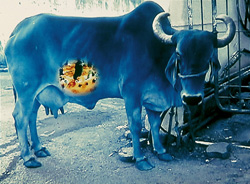

 Nalini Malani’s video installations sometimes indirectly address a world that does not yet exist, in which standard cleavages between race, religion and ethnicity either have not yet passed the point of reconciliation, or they have somehow been circumvented by the actions of the enlightened many. Her immense installation for the 2003 Istanbul Biennial, Gamepieces, deployed the Yerebatan cistern as the screen for an elaborately layered, looping projection of shadow puppetry combined with video. Using very simple transparent mylar rings on which she painted frizes of figures in various ‘ethnic’ styles, Malani is able to build up an elaborate visual metaphor for the constant intermingling of particular cultures, which invariably emerge stronger and more energized from their encounters, although the other, more sinister, option – symbolized by the mushroom clouds of atomic bombs – is never far at hand.
Nalini Malani’s video installations sometimes indirectly address a world that does not yet exist, in which standard cleavages between race, religion and ethnicity either have not yet passed the point of reconciliation, or they have somehow been circumvented by the actions of the enlightened many. Her immense installation for the 2003 Istanbul Biennial, Gamepieces, deployed the Yerebatan cistern as the screen for an elaborately layered, looping projection of shadow puppetry combined with video. Using very simple transparent mylar rings on which she painted frizes of figures in various ‘ethnic’ styles, Malani is able to build up an elaborate visual metaphor for the constant intermingling of particular cultures, which invariably emerge stronger and more energized from their encounters, although the other, more sinister, option – symbolized by the mushroom clouds of atomic bombs – is never far at hand.
If this politically visionary aspect of Malani’s art is so pronounced, it is probably because it runs so thoroughly counter to the prevailing winds of identity at the moment, especially in a hyper-metropolis like Mumbai, where Hindu-Muslim tensions are routinely stoked by the ultra-nationalist right, exacerbating an already difficult tension due to terrorist bombings that are inevitably linked to Pakistan. Malani, whose home city, Karachi, became part of another country shortly after her birth, tends to see the partition of India and Pakistan – or rather the way it was administered and carried out – as the sixty-year-old trauma that provides the shared source of both country’s woes right up to the present.
Mother India, Malani’s five-channel video installation for Taipei, explores dimensions of Hindu nationalist ideology that, even with their specificity to time and place, ring uncannily true in many other parts of the world today. Treating the subject of women’s bodies as part of the creation of a Hindu state in the 1940s, ‘Mother India’ explores the experiences of the hundreds of thousands of women who were raped in the process. Arguing for historical transparency and espousing an activist’s approach to tolerance, Malani dares to suggest a future for India that is fully in keeping with its increasingly important role as the world’s largest democracy. With diversity comes understanding, and from there acceptance, with only one other question remaining: will knowing this ever prevent people from killing and violating one another in the name of a divine birthright?